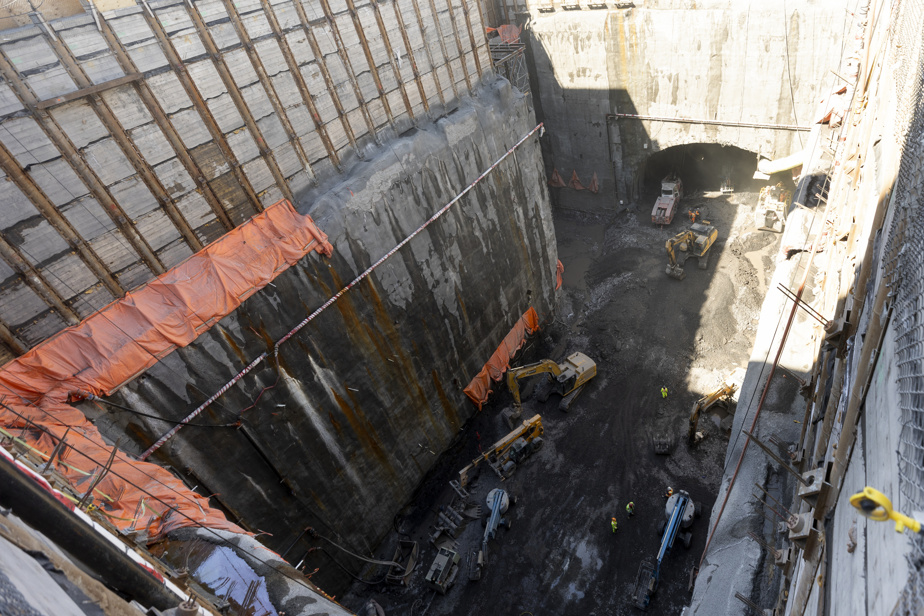While construction sites in Quebec are smashing construction residue production records, Montreal-Trudeau Airport (YUL) is carrying out almost zero-waste work. Whether for the rehabilitation of an airstrip or inside the gigachantier of the future REM station, contractors must recycle and revalorize their waste.
Jean-Pierre Bernier, environment manager for major projects at Aéroports de Montréal (ADM), made an appointment with The Press at gate 25, at 11:50 a.m. sharp, near international arrivals. We had to comply with the safety instructions, put on the regulatory boots, then Martin Massé, vice-president of sustainable development, and Jean-Pierre Bernier opened the way for us through plywood tunnels.
“What we achieve here with construction waste are the standards of tomorrow. After dark years, Montreal is finally becoming an international city with this access point to the city center,” says Mr. Massé, stopping dry on the side of a hole that must be 35 meters deep. This is the future YUL–Montréal-Trudeau station of the REM, whose commissioning (now scheduled for 2027) has been delayed.

PHOTO MARCO CAMPANOZZI, THE PRESS
Jean-Pierre Bernier, environmental manager for major projects at Aéroports de Montréal, and Martin Massé, vice-president of sustainable development
Right next to the crater, a mechanical shovel dumps a mixture of earth and gravel continuously. According to a compilation made by ADM, the airport’s REM construction site has posted a recovery rate of 99.3% since its opening. In order to achieve this, Mr. Bernier explains that the mixture extracted from the ground is subject to on-site sorting, with a system of mechanical sieves, to then be destined for reuse.
The contractor must guarantee us a recycling and recovery rate of at least 90% of its residues. It is up to him to find a center to reuse what comes out of the ground.
Jean-Pierre Bernier, environmental manager for major projects at ADM
“We require a register showing the mode of management and the destination by category of materials”, specifies the head of the environment. He has become the watchdog for waste collection at the airport somewhat in spite of himself, he concedes.
Martin Massé adds that the residues must be stored in such a way as not to contaminate runoff water. Failure to achieve the targets at the end of the project entails substantial financial penalties, he assures.
According to him, all these environmental rules will eventually pay off for exemplary companies. “It’s still a small environment, construction. In a sense, it’s an investment for businesses. They are making a name for themselves with managers of major works like us. »
More than 3 million tons of residues per year
Each year, 3.5 million tonnes of construction, renovation and demolition (CRD) waste are produced in Quebec, according to data collected by Recyc-Québec. By way of comparison, the old structure of the Champlain Bridge generated 250,000 tonnes of concrete, 25,000 tonnes of steel and 12,000 tonnes of asphalt to recover.

PHOTO MARCO CAMPANOZZI, THE PRESS
Every year, 3.5 million tons of construction, renovation and demolition (CRD) waste are produced in Quebec.
In this context, a construction site that achieves a recycling or revaluation rate of 90% of its residues is qualified as “zero waste”, explains Brigitte Geoffroy, spokesperson for Recyc-Québec.
According to her, this rate is made possible thanks to a sorting at the source. “The materials are not mixed. We have supported the ADM in various projects, they have a good overall vision. One of the keys to reducing construction residues is to plan measures upstream. CRD management procedures must be provided for in the specifications. For example, there is no reason not to recover and reuse wood,” adds Mme Geoffrey.
Competition
In Quebec, other major construction sites serve as an example in the field of waste recovery. The Jacques-Cartier and Champlain bridges company had the idea of launching a Canada-wide competition, whose finalists will be announced shortly, in order to give a second life to its old materials through art and architecture.
At Recyc-Québec, we explain that the future of construction will necessarily go through “upcycling or recycling”, which means recovering materials or products that no longer have their original use to transform them into superior quality or usefulness.
“The future also involves pooling spaces, that is to say that we have to ask ourselves questions about what has already been built and about reconstruction,” says Brigitte Geoffroy. Secondly, there is the notion of design, the choice of materials, durability. The key to success involves tools to reduce CRD waste at source, with monitoring grids, among other things. »
Learn more
-
- GPS
- At Montréal-Trudeau airport, the measures go as far as the mandatory real-time monitoring, by GPS, of the loading of materials.
Montreal Airports
